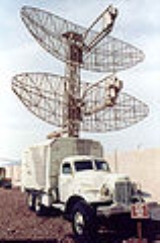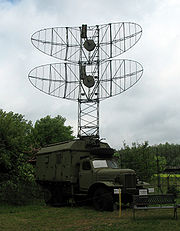
P-15 radar
Encyclopedia
The P-15 "Tropa" or 1RL12 (also referred to by the NATO reporting name
"Flat Face A"in the west) is a 2D UHF radar
developed and operated by the former Soviet Union
.
. The P-15 was designed to detect aircraft flying at low altitude and came to be associated with the S-125
"Neva" anti-aircraft system (NATO reporting name SA-3 "Goa"), though it was later replaced by the P-15M2 "Squat Eye" radar which mounted a single radar antenna on a 20-30 meter mast to improve coverage.
In 1959 the modernised P-15M "trail" radar passed through the state test program, the modernisation replacing outdated mercury based electronics. In 1962 another modernisation of the P-15 passed through trials as the P-15N, the radar being developed and produced by the Ulyanovsk Mechanical Plant. The P-15N introduced a more sensitive receiver
which improved the detection range and a new amplifier
for the transmitter
. Further improvements were made in 1970 when the P-15MN passed trails, the P-15MN included a pulse coherent Doppler
filter (moving target indicator) to remove passive clutter (by up to 50 dB), the first radar to employ the method in the Soviet Union. Finally by 1974 the modernisation of the P-15 was so extensive that it resulted in a new designation, the P-19
"Danube" also known as the 1RL134 and known in the west as the Flat Face B.
 The P-15 is a high mobility radar and with the antenna mounted directly on the single truck (Zil-157) used for transport and the system was able to be deployed and taken down in no more than 10 minutes.. The P-15 uses two open frame elliptical parabolic
The P-15 is a high mobility radar and with the antenna mounted directly on the single truck (Zil-157) used for transport and the system was able to be deployed and taken down in no more than 10 minutes.. The P-15 uses two open frame elliptical parabolic
antenna
accomplishing both transmission
and reception, each antenna being fed by a single antenna feed. The radar can rapidly shift its frequency
to one of four pre-set frequencies to avoid active interference with passive interference being removed by a coherent doppler filter. Azimuth was determined by mechanical scanning with an associated accompanying PRV-11 (NATO reporting name "Side Net") used to determine elevation. A secondary radar for IFF
is generally used in conjunction with the P-15, generally the 1L22 "Parol".
NATO reporting name
NATO reporting names are classified code names for military equipment of the Eastern Bloc...
"Flat Face A"in the west) is a 2D UHF radar
Radar
Radar is an object-detection system which uses radio waves to determine the range, altitude, direction, or speed of objects. It can be used to detect aircraft, ships, spacecraft, guided missiles, motor vehicles, weather formations, and terrain. The radar dish or antenna transmits pulses of radio...
developed and operated by the former Soviet Union
Soviet Union
The Soviet Union , officially the Union of Soviet Socialist Republics , was a constitutionally socialist state that existed in Eurasia between 1922 and 1991....
.
Development
In 1952 SRI-244 started development of what become the P-15 early warning radar, by 1955 the radar had passed state trials and was accepted into service with the anti-aircraft troops of the Soviet armed forcesSoviet Armed Forces
The Soviet Armed Forces, also called the Armed Forces of the Union of Soviet Socialist Republics and Armed Forces of the Soviet Union refers to the armed forces of the Russian SFSR , and Soviet Union from their beginnings in the...
. The P-15 was designed to detect aircraft flying at low altitude and came to be associated with the S-125
S-125
The Isayev S-125 Neva/Pechora Soviet surface-to-air missile system was designed to complement the S-25 and S-75. It has a shorter effective range and lower engagement altitude than either of its predecessors and also flies slower, but due to its two-stage design it is more effective against more...
"Neva" anti-aircraft system (NATO reporting name SA-3 "Goa"), though it was later replaced by the P-15M2 "Squat Eye" radar which mounted a single radar antenna on a 20-30 meter mast to improve coverage.
In 1959 the modernised P-15M "trail" radar passed through the state test program, the modernisation replacing outdated mercury based electronics. In 1962 another modernisation of the P-15 passed through trials as the P-15N, the radar being developed and produced by the Ulyanovsk Mechanical Plant. The P-15N introduced a more sensitive receiver
Receiver (radio)
A radio receiver converts signals from a radio antenna to a usable form. It uses electronic filters to separate a wanted radio frequency signal from all other signals, the electronic amplifier increases the level suitable for further processing, and finally recovers the desired information through...
which improved the detection range and a new amplifier
Amplifier
Generally, an amplifier or simply amp, is a device for increasing the power of a signal.In popular use, the term usually describes an electronic amplifier, in which the input "signal" is usually a voltage or a current. In audio applications, amplifiers drive the loudspeakers used in PA systems to...
for the transmitter
Transmitter
In electronics and telecommunications a transmitter or radio transmitter is an electronic device which, with the aid of an antenna, produces radio waves. The transmitter itself generates a radio frequency alternating current, which is applied to the antenna. When excited by this alternating...
. Further improvements were made in 1970 when the P-15MN passed trails, the P-15MN included a pulse coherent Doppler
Pulse-doppler radar
Pulse-Doppler is a 4D radar system capable of detecting both target 3D location as well as measuring radial velocity . It uses the Doppler effect to avoid overloading computers and operators as well as to reduce power consumption...
filter (moving target indicator) to remove passive clutter (by up to 50 dB), the first radar to employ the method in the Soviet Union. Finally by 1974 the modernisation of the P-15 was so extensive that it resulted in a new designation, the P-19
P-19 radar
The P-19 "Danube" 1RL134 is a 2D UHF radar developed and operated by the former Soviet Union...
"Danube" also known as the 1RL134 and known in the west as the Flat Face B.
Description

Parabolic antenna
A parabolic antenna is an antenna that uses a parabolic reflector, a curved surface with the cross-sectional shape of a parabola, to direct the radio waves. The most common form is shaped like a dish and is popularly called a dish antenna or parabolic dish...
antenna
Antenna (radio)
An antenna is an electrical device which converts electric currents into radio waves, and vice versa. It is usually used with a radio transmitter or radio receiver...
accomplishing both transmission
Transmission (telecommunications)
Transmission, in telecommunications, is the process of sending, propagating and receiving an analogue or digital information signal over a physical point-to-point or point-to-multipoint transmission medium, either wired, optical fiber or wireless...
and reception, each antenna being fed by a single antenna feed. The radar can rapidly shift its frequency
Frequency
Frequency is the number of occurrences of a repeating event per unit time. It is also referred to as temporal frequency.The period is the duration of one cycle in a repeating event, so the period is the reciprocal of the frequency...
to one of four pre-set frequencies to avoid active interference with passive interference being removed by a coherent doppler filter. Azimuth was determined by mechanical scanning with an associated accompanying PRV-11 (NATO reporting name "Side Net") used to determine elevation. A secondary radar for IFF
IFF
IFF, Iff or iff may refer to:Technology/Science:* Identification friend or foe, an electronic radio-based identification system using transponders...
is generally used in conjunction with the P-15, generally the 1L22 "Parol".

